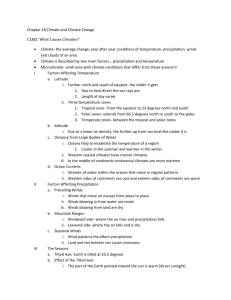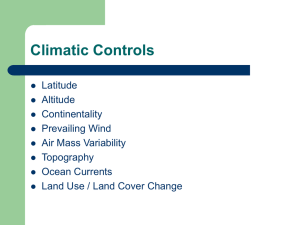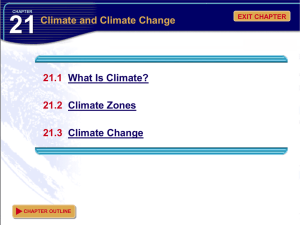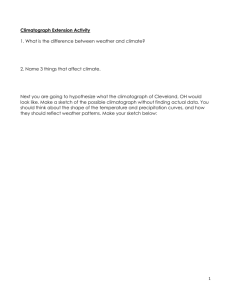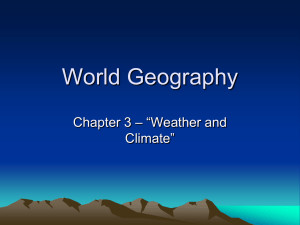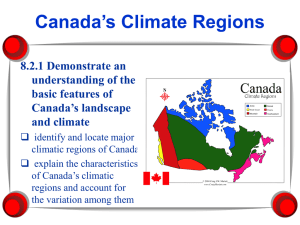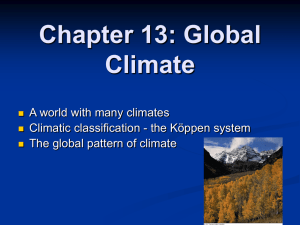Chapter 17
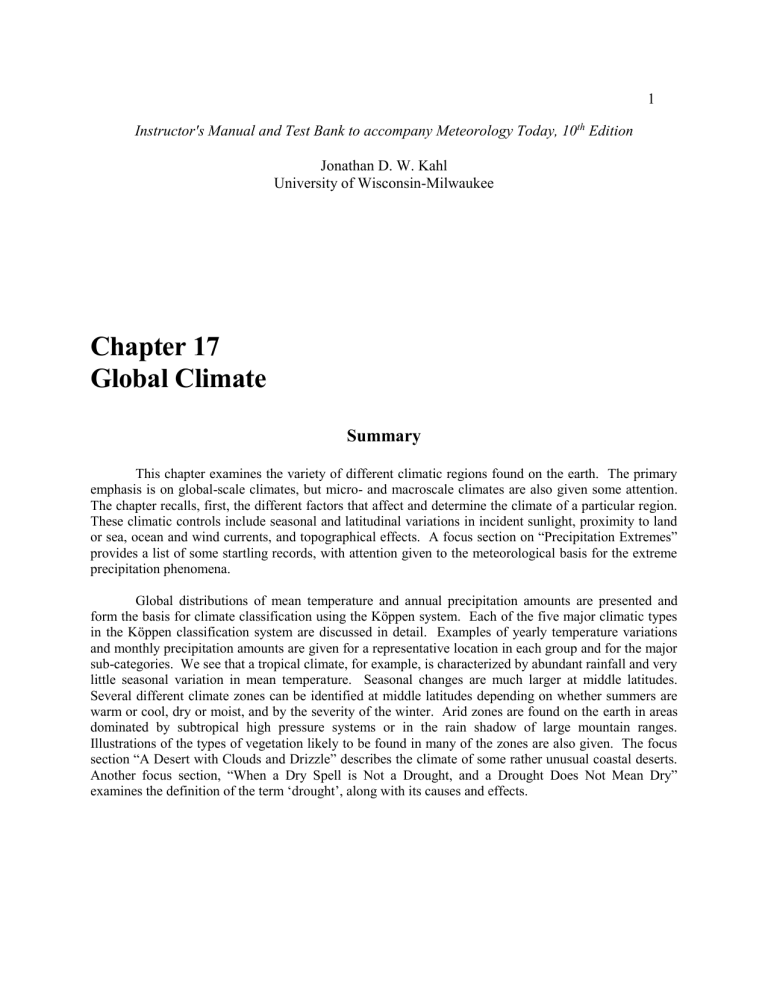
1
Instructor's Manual and Test Bank to accompany Meteorology Today, 10
th
Edition
Jonathan D. W. Kahl
University of Wisconsin-Milwaukee
Chapter 17
Global Climate
Summary
This chapter examines the variety of different climatic regions found on the earth. The primary emphasis is on global-scale climates, but micro- and macroscale climates are also given some attention.
The chapter recalls, first, the different factors that affect and determine the climate of a particular region.
These climatic controls include seasonal and latitudinal variations in incident sunlight, proximity to land or sea, ocean and wind currents, and topographical effects. A focus section on “Precipitation Extremes” provides a list of some startling records, with attention given to the meteorological basis for the extreme precipitation phenomena.
Global distributions of mean temperature and annual precipitation amounts are presented and form the basis for climate classification using the Köppen system. Each of the five major climatic types in the Köppen classification system are discussed in detail. Examples of yearly temperature variations and monthly precipitation amounts are given for a representative location in each group and for the major sub-categories. We see that a tropical climate, for example, is characterized by abundant rainfall and very little seasonal variation in mean temperature. Seasonal changes are much larger at middle latitudes.
Several different climate zones can be identified at middle latitudes depending on whether summers are warm or cool, dry or moist, and by the severity of the winter. Arid zones are found on the earth in areas dominated by subtropical high pressure systems or in the rain shadow of large mountain ranges.
Illustrations of the types of vegetation likely to be found in many of the zones are also given. The focus section “A Desert with Clouds and Drizzle” describes the climate of some rather unusual coastal deserts.
Another focus section, “When a Dry Spell is Not a Drought, and a Drought Does Not Mean Dry” examines the definition of the term ‘drought’, along with its causes and effects.
2
Teaching Suggestions
1. Before beginning the presentation on global climate, ask students to speculate on where the warmest, coldest, wettest and driest regions are found. Have them present reasons for their choices.
Keep note of these speculations when presenting the chapter’s material.
2. Initially, the variety of labels used for the major groups and subcategories in the Köppen classification system may be confusing to students. Keep a map, such as the Köppen classification map provided in the chapter, displayed throughout the discussion and use a specific city or region to illustrate each climatic zone.
3. Encourage students to learn the Köppen classification groups by understanding the differences between them and the cause of those differences. Show how climate depends on latitude by observing the changes that occur as one moves in a line from the equator toward the North Pole at constant longitude.
Then examine how climate is modified as one moves from west to east across the United States at a single middle latitude. Show where features in the global circulation such as the subtropical highs and the ITCZ are located at various times during the year and explain how these affect climate.
4. Present and discuss representative examples (plots of average temperature and monthly precipitation totals) of each of the important climate types. List one or two of the key characteristics that can be used to distinguish between the different climate classifications. Then present some new data, but do not reveal the location where the data was obtained. Ask the students how these data would be classified. Ask the students where, within a particular region such as the United States, these data might have been obtained. After a period of discussion, reveal the actual location. This is also a good point to be sure that students are familiar with United States and world geography.
5. Ask students to describe any microclimates they’re aware of.
6.
Have students vote on their favorite Köppen climate type.
7. Compare your local climate with that of a location at the same latitude/longitude in the southern hemisphere. Discuss the similarities and/or differences.
8. Is your local area, or a nearby state, in the midst of a dry spell or drought? If so, discuss the situation in relation to concepts presented in the chapter.
9. Discuss the major influences on the climate of your location.
Student Projects
1. Have students collect and prepare a plot of yearly average temperature data and average monthly precipitation totals for their city. How would their town be classified using the Köppen system?
2. Have students attempt to locate different macroscale climate regions in the city where they live.
The students will have to devise a system to be used to identify and classify different climate zones.
Students could, for example, compare average conditions in high- and low-lying areas in their town, average conditions near and far from a body of water, or conditions inside a city with conditions in a rural
3 area nearby. Are there significant differences in macroscale climates in their city? Are any differences reflected in the vegetation found at different locations within the city?
3. Have the students look for different microscale climatic environments. Students could, for example, compare average conditions on the north- and south-facing sides of a large building. Students would have to determine what measurements or observations could be made to identify and classify different microscale environments.
4. In some locations, students could identify and classify the different climatic zones found at different altitudes on a nearby mountain range. Students could, for example, determine the predominant vegetation types at different levels and attempt to relate this seasonal temperature and precipitation variations.
5. Have students interview a professional meteorologist to learn their views on climate change.
Answers to Questions for Review
1. The general circulation of the atmosphere; distribution of mountain ranges and high plateaus; temperature; passage of high and low pressure systems; proximity to semi-permanent highs and lows; proximity to large open water sources.
2. Winter: Pacific high moves south, giving storms access to the west coast of the U.S., Bermuda high moves south, carrying less moisture to the eastern half of the U.S. Summer: Pacific high inhibits precipitation along the West Coast, Bermuda high brings moisture to eastern two-thirds of the U.S.
3. Along the coastlines, the reduced albedo and larger thermal capacity of nearby water increases the temperatures.
4. Vegetation type.
5. Tropical moist climate: All months have an average temperature above 18°C (64°F). Polar climate: Extremely cold winters and summers. The average temperature of the warmest month is below
10°C (50°F).
6. (a) D – Moist climate with severe winter.
(b) A – Moist tropical climate.
(c) B – Dry climate.
7. Potential evapotranspiration exceeds precipitation.
8. Tropical rain forest: Tropical Moist Climate. Xerophytes: B – Dry climate. Steppe: B – Dry climate. Taiga: D – Moist climates with severe winters. Tundra: E – Polar climates. Savanna: A – Moist tropical climate.
9. (a) tropical wet and dry: In summer, the ITCZ moves poleward, bringing with it heavy precipitation, usually in the form of showers. Rainfall is enhanced by slow moving shallow lows that move through the region. Tropical wet-and-dry climates not only receive less total rainfall than the
4 tropical wet climates, but the rain that does occur is much less reliable, as the total rainfall often fluctuates widely from one year to the next. In the course of a single year, for example, destructive floods may be followed by serious droughts. As with tropical wet regions, the daily range of temperature usually exceeds the annual range, but the climate here is much less monotonous. There is a cool season in winter when the maximum temperature averages 30°C to 32°C (86°F to 90°F). At night, the low humidity and clear skies allow for rapid radiational cooling and, by early morning, minimum temperatures drop to 20°C
(68°F) or below.
(b) Mediterranean: The extreme summer aridity of the Mediterranean climate, which in California may exist for five months, is caused by the sinking air of the subtropical highs. In addition, these anticyclones divert summer storm systems poleward. During the winter, when the subtropical highs move equatorward, mid-latitude storms from the ocean frequent the region, bringing with them much needed rainfall. Consequently, Mediterranean climates are characterized by mild, wet winters, and mild-to-hot, dry summers.
(c) marine: During much of the year, marine climates are characterized by low clouds, fog, and drizzle. The ocean’s influence produces adequate precipitation in all months, with much of it falling as light or moderate rain associated with maritime polar air masses. Snow does fall, but frequently it turns to slush after only a day or so. In some locations, topography greatly enhances precipitation totals.
(d) humid subtropical: A trademark of the humid subtropical climate is its hot, muggy summers.
This sultry summer weather occurs because Cfa climates are located on the western side of subtropical highs, where maritime tropical air from lower latitudes is swept poleward into these regions. Generally, summer dew-point temperatures are high (often exceeding 23°C, or 73°F) and so is the relative humidity, even during the middle of the day. The high humidity combines with the high air temperature (usually above 32°C, or 90°F) to produce more oppressive conditions than are found in equatorial regions.
Summer morning low temperatures often range between 21°C and 27°C (70°F and 81°F). Occasionally, a weak summer cool front will bring temporary relief from the sweltering conditions.
(e) subpolar: The exceedingly low temperatures of winter account for these areas being the primary source regions for continental polar and arctic air masses. Extremely cold winters coupled with cool summers produce large annual temperature ranges. Precipitation is comparatively light in the subpolar climates, especially in the interior regions, with most places receiving less than 50 cm (20 in.) annually. A good percentage of the precipitation falls when weak cyclonic storms move through the region in summer. The total snowfall is usually not large but the cold air prevents melting, so snow stays on the ground for months at a time. Because of the low temperatures, there is a low annual rate of evaporation that ensures adequate moisture to support the boreal forests of conifers and birches known as taiga.
(f) polar ice cap: It occupies the interior ice sheets of Greenland and Antarctica, where the depth of ice in some places measures thousands of meters. In this region, temperatures are never much above freezing, even during the middle of “summer.” The coldest places in the world are located here.
Precipitation is extremely meager with many places receiving less than 10 cm (4 in.) annually. Most precipitation falls as snow during the “warmer” summer. Strong downslope katabatic winds frequently whip the snow about, adding to the climate’s harshness.
10. C: humid with mild winters. D: Warm-to-cool summers and cold winters.
11. D climates are controlled by a large continent, and continents typically experience a larger annual temperature range as compared to oceans.
12. There are fewer large continents in the southern hemisphere, and the largest southern hemisphere land masses are in the tropics.
5
13. The tropical wet-and-dry climate has a distinct dry season, whereas the tropical rain forest
(tropical wet) climate does not.
14. Because winds (outside the tropics) are typically westerly, giving the west coasts a marine influence.
15. Winters are colder in Dfa climates.
16. Arid deserts are dominated by the sinking air of a subtropical high pressure system. This factor prevents significant precipitation even if oceans are nearby.
17.
Köppen found that the average monthly temperature of 10°C tended to represent the minimum temperature required for tree growth.
18. The southern desert region of North America is dry because it is dominated by the subtropical high most of the year, and winter storm systems tend to weaken before they move into the area. The northern region is in the rain shadow of the Sierra Nevada. These regions are deficient in precipitation all year long, with many stations receiving less than 13 cm (5 in.) annually.
19. In the polar tundra (ET), the average temperature of the warmest month is below 10°C (50°F), but above freezing. The temperature, rather than the precipitation, is the defining factor of this climate type.
20. Because of the low temperatures, there is a low annual rate of evaporation that ensures adequate moisture to support the boreal forests of conifers and birches known as taiga. Hence, the subpolar climate is known also as a boreal climate and as a taiga climate.
Answers to Questions for Thought
1. Cities located east of the Rockies receive moisture from the Gulf of Mexico. The Rockies effectively block Gulf moisture from reaching cities located to the east of the Sierra Nevada Mountains.
In addition, the Sierras shield the region east of them from Pacific moisture.
3. The prevailing westerly winds at this latitude give Boston a continental-type climate.
4. In polar regions, the ground is frozen except in summer when the upper part thaws. Hence, the summer landscape often turns swampy. During the winter, warmth from a heated building could melt the frozen ground beneath it. This could cause the structure to settle into the ground unevenly. To prevent this, some structures are built upon pilings.
5. The ground in Cfa climate areas is often drier than the ground in areas with Af climates. Dry ground warms up faster than wet ground, allowing surface temperatures to increase.
7. In arid desert climates. Here the temperatures are warm enough to support liquid precipitation, but relative humidities are low enough to evaporate the rain before it reaches the surface.
8. San Francisco is closer to the Pacific Ocean and experiences a maritime climate. Sacramento is inland, and air approaching Sacramento from the west must first cross a mountain range where it may
6 contain less moisture due to orographic lifting and precipitation.
9. The Rocky Mountains are very tall and are oriented perpendicular to the prevailing wind flow
(westerly). The Appalachians are shorter and are roughly parallel to the prevailing wind directions
(southerly and northerly).
Answers to Critical Thinking Questions
Figure 17.6. Students might discuss mild winter climates warming slightly and changing to dry climates, increasing the area occupied by dry climates. Another possibility is increased precipitation accompanying increased evaporation, resulting in a decrease of the area occupied by dry climates.
Figure 17.26. Summers would have to warm up with winters remaining severe.
7
Multiple Choice Exam Questions
1. d. global climate e. none of the above
ANSWER: E
2.
Which of the following refers to day-to-day weather variability? a. microclimate b. mesoclimate c. macroclimate
The climate of an area about the size of a town would be described as a. mesoclimate. b. macroclimate. c. microclimate. d. urban climate.
ANSWER: A
3. Which of the following is considered a climatic control? a. ocean currents b. intensity of sunshine and its variation with latitude c. prevailing winds d. altitude e. all of the above
ANSWER: E
4. Which section of the United States is most likely to experience a persistent subsidence inversion during the summer? a. Pacific Coastal regions b. Central Plains c. Southern Florida d. Atlantic Coastal regions e. Midwest
ANSWER: A
5. A rainshadow desert is normally found a. in the center of a large surface anticyclone. b. on the back (western) side of a large thunderstorm. c. in polar regions where the air is cold and dry. d. in the center of the ITCZ. e. on the downwind side of a mountain range.
ANSWER: E
6. The greatest likelihood of experiencing a dry month of February would be along
8 a. the equator. b. the west coast of Mexico (latitude 20°N). c. the Southern California coast (latitude 35°N). d. the Gulf Coast near New Orleans (latitude 30°N). e. the coast of southern Alaska (latitude 60°N).
ANSWER: B
7. The rainiest places in the world are usually located a. downwind from mountain ranges. b. in the region of the subtropical highs. c. on the windward side of mountains. d. in the middle of continents. e. along the western side of continents.
ANSWER: C
8. Which of the following is not considered a climatic control? a. altitude b. mountain barriers c. ocean currents d. insolation e. none of the above
ANSWER: E
9. What do Dallol, Ethiopia, Death Valley, California, and El Azizia, Libya, have in common? a. They are all in third-world countries. b. They are three of the hottest places on the earth. c. They are three of the coldest places on the earth. d. They all have frequent snowstorms.
ANSWER: B
10. The earth's rainforests are found in a. humid subtropical (Cfa) climates. b. tropical wet (Af) climates. c. tropical wet and dry (Aw) climates. d. all of the above
ANSWER: B
11. The lowest average temperatures in the world occur in a. North America. b. Northwestern Europe. c. the Arctic. d. the Antarctic. e. Northern Siberia.
9
ANSWER: D
12. Which of the following help explain why the lowest average temperatures in the world are found in Antarctica? a. dry air b. high altitude c. surface reflects incident sunlight d. all of the above
ANSWER: D
13.
The Köppen scheme for classifying climates employs annual and monthly averages of a. temperature and precipitation. b. precipitation and stream runoff. c. ocean levels and surface pressure. d. population density and agricultural output. e. sunshine and soil type.
ANSWER: A
14. The coldest regions of large continents are usually on the west coast. a. true b. false
ANSWER: B
15. In Thornthwaite's P/E index, the "P" and "E" stand for a. precipitation and evaporation. b. precipitation and energy (available). c. potential sunlight and energy. d. potential sunlight and evaporation.
ANSWER: A
16. Savanna grass would most likely be associated with which climate type? a. tropical rainforest (Af) b. tropical monsoon (Am) c. semi-arid (BS) d. tropical wet-and-dry (Aw)
ANSWER: D
17. The term monsoon refers to a. the short summer rainy season observed in some locations. b. a short dry season. c. a period of heavy rainfall produced by thunderstorms. d. a seasonal shift in wind circulation.
10
ANSWER: D
18. The climate classification for a region with average monthly temperatures that remain above
18°C (64°F) throughout the year and abundant rainfall, except for a short one or two month dry period, would probably be a. tropical wet (Af). b. moist subtropical (Cs). c. tropical monsoon (Am). d. humid continental (Dfa).
ANSWER: C
19. Which below is not characteristic of a tropical wet climate (Af)? a. greater temperature variation between day and night than between the warmest and coolest months of the year b. extremely high afternoon temperatures, usually much higher than those experienced in middle latitudes c. abundant rainfall all year long d. afternoon showers and high humidity
ANSWER: B
20. The tropical wet-and-dry climate is influenced mainly by the a. polar front and the subtropical highs. b. polar front and the ITCZ. c. subtropical highs and polar front. d. ITCZ and subtropical highs. e. subtropical highs and polar lows.
ANSWER: D
21. In a tropical wet-and-dry climate, the dry season occurs with the a. high sun period (summer). b. low sun period (winter). c. close proximity of the ITCZ. d. all of the above
ANSWER: B
22. In a dry climate, a. there are no plants. b. potential evaporation and transpiration exceed precipitation. c. there is no precipitation. d. air temperatures seldom drop below freezing and days are always hot. e. winters are short, but cold.
ANSWER: B
23. The most abundant climate type over the face of the earth is
a. moist tropical climates. b. dry climates. c. moist subtropical mid-latitude climates. d. moist continental climates. e. polar climates.
ANSWER: B
24. The highest temperatures in the world occur in a. tropical moist climates. b. subtropical moist climates. c. continental moist climates. d. continental dry climates. e. subtropical deserts.
ANSWER: E
25. The global distribution of precipitation is closely associated with a. latitude. b. distribution of mountain ranges and high plateaus. c. the general circulation of the atmosphere. d. all of the above
ANSWER: D
26. Which of the following climatic regions would probably have the largest daily temperature range? a. tropical wet climate b. arid climate c. east coast marine climate d. Mediterranean climate
ANSWER: B
27. Deserts that experience low clouds and drizzle tend to be found mainly a. in the center of continents. b. in the rain shadow of a mountain. c. on the eastern side of continents. d. on the western side of continents. e. on small islands near the equator.
ANSWER: D
28. One would most likely experience steppe vegetation in a a. semi-arid climate. b. humid subtropical climate. c. marine climate. d. subpolar climate. e. tropical wet-and-dry climate.
11
12
ANSWER: A
29. Locations at middle latitudes with monthly average temperatures in the winter that are below
18°C (64°F), but above -3°C (27°F) have ____ climates. a. humid subtropical b. moist continental c. semi-arid d. steppe
ANSWER: A
30. A humid subtropical climate is found in what region of the United States? a. Southwest b. Southeast c. Central Plains d. Southern California
ANSWER: B
31. A city located on the east coast of the United States with hot, muggy summers and mild winters
(the average temperature of the coldest month is above -3°C (27°F)) has a ____ climate. a. moist subtropical (Cfa) climate b. Mediterranean (Cs) climate c. tropical wet and dry climate (Aw) d. moist continental (Dfa)
ANSWER: A
32. To be considered a moist continental climate, a. winter snowfall must exceed summer rainfall. b. monthly average temperatures must fall below -3°C (27°F) during the winter. c. total rainfall must exceed 60 inches. d. a region must be located more than 500 miles from the nearest ocean.
ANSWER: B
33. A city on the west coast of the United States with mild winters and a long cool summer would have a ____ climate. a. moist subtropical (Cfb) b. tropical wet and dry (Aw) c. moist continental (Dfa) d. semi-arid (BS)
ANSWER: A
34. According to Köppen's classification of climates, marine climates are observed in the United
States mainly along a. the Pacific Northwest coast.
13 b. coastal areas of the middle Atlantic states. c. the coast of New England. d. the Gulf Coast. e. coastal margins of Southern California.
ANSWER: A
35. Mediterranean climates are characterized by a. cool, wet winters and mild to hot, dry summers. b. cold, wet winters and hot, humid summers. c. cold, relatively dry winters and mild, humid summers. d. mild, wet winters and mild, humid summers. e. cold, snowy winters and hot, dry summers.
ANSWER: A
36. The primary reason for the dry summer subtropical climate in North America is a. that storms do not form in summer. b. that the air is too cool to produce adequate precipitation. c. the Pacific high moves north in summer. d. the ITCZ moves north in summer. e. the Bermuda high intensifies and shifts northward in summer.
ANSWER: C
37. One would not expect to experience a D-type climate in: a. Alaska. b. New England. c. Southern Canada. d. South America.
ANSWER: D
38. Which climate type normally has the largest annual range in temperature? a. tropical climates b. humid-subtropical climates c. polar ice cap climates d. subpolar climates e. dry climates
ANSWER: D
39. In an east-west oriented mountain range, a rain shadow could be found on the ____ of the range. a. east or west b. north or south c. both east or west and north or south
ANSWER: B
14
40. A region with long, very cold winters and average temperatures that exceed 10°C (50°F) only one or two months during the summer would have ____ climate. a. a subpolar (Dfc) b. a polar tundra (ET) c. a polar ice cap (EF) d. an alpine (An)
ANSWER: A type?
41. Thawing of an upper layer of permafrost would most likely be observed in which climatic a. polar ice cap b. humid continental with warm summers c. humid subtropical d. polar tundra
ANSWER: D
42. Average monthly temperatures that exceed 0°C (32°F) but remain below 10°C (50°F) are characteristic of a. the polar ice cap (EF) climate zone. b. the subpolar (Dfc) climate zone. c. the polar tundra (ET) climate zone. d. alpine (An) climate zone.
ANSWER: C
43. Within the continental United States (excluding Alaska), one could observe a. taiga. b. polar tundra. c. polar icecap. d. all of the above
ANSWER: D
44. Tree growth is not possible in a region where a. annual precipitation is 20 inches or less. b. average monthly temperatures never exceed 10°C (50°F). c. average monthly temperatures are sometimes less than 0°C (32°F). d. evaporation exceeds total annual precipitation.
ANSWER: B
45. When the average temperature of the warmest month averages 0°C (32°F) or below, Köppen classified this as a ____ climate. a. subpolar b. polar ice cap c. polar tundra d. arctic
15
ANSWER: B
46. When the average temperature of the warmest month of a region averages above freezing, but below 10°C (50°F), you might expect to observe what type of vegetation there? a. savanna grass b. tundra c. taiga d. None - it's too cold for anything to grow.
ANSWER: B
47. The climate of a city situated high in the mountains of the middle latitudes would, according to
Köppen, be classified as a. tundra. b. subpolar. c. alpine. d. highland.
ANSWER: D
48. The variety of climatic zones that one observes on a mountain is due primarily to differences in a. atmospheric pressure. b. relative humidity. c. rainfall amounts. d. temperature.
ANSWER: D
49. A location in the center of a large, mid-latitude continent is likely to experience a. a precipitation maximum during winter. b. a precipitation maximum during summer. c. abundant precipitation all year long. d. little precipitation at any time of year.
ANSWER: B
50. The coldest areas of the northern hemisphere are found ____ of large land masses. a. in the interior b. on the periphery
ANSWER: A
Essay Exam Questions
1. In general, would you expect to find more rainfall on the western side or the Eastern side of the subtropical high pressure centers? How does this affect climatic conditions along the east and
16 west coast of the United States?
2. The hottest places on earth are not found near the equator in tropical wet climates, but, rather, in arid climate regions. Why is this true?
3.
4.
Discuss some of the factors that determine where the wettest places in the world are found.
What meteorological information is the primary basis for climate classification using the Köppen system?
5. The greatest one-month rainfall total (366 in.) occurred in Cherrapunji, India, in July of 1861.
The greatest 24 hour rainfall total (43 in.) in the United States occurred in Alvin, Texas, on July
25, 1979. The greatest 42 minute rainfall total (12 in.) occurred in Holt, Missouri, on June 22,
1947. What meteorological conditions do you think produced these record precipitation amounts?
6. Describe the climate of and the microclimatic variation within the neighborhood in which you live.
7. What differences exist between tropical wet (Af), tropical monsoon (Am), and tropical wet and dry (Aw) climates? Would you expect to observe any significant differences in types of vegetation in these different climates groups?
8. A yearly rainfall of 14 inches in a hot climate will support only sparse vegetation. The same total amount of rain in north central Canada would support a conifer forest. Why is this possible?
9. How is it possible for regions with a desert climate to be found next to an ocean, which you might expect to be an abundant source of moist air?
10. Where is the Mojave Desert located? What factors account for the Mojave Desert being found there?
11. Identify and describe the different climatic zones you would observe if you traveled from west to east across the middle of the United States?
12. Compare the climate of your town with that of another location at the same latitude, but in a different continent. Explain any similarities or differences.
13. Seattle, Washington (lat. 47.5
o N) has a coastal Mediterranean (Csb) climate. New York, New
York (41 o N) has a humid subtropical (Cfa) climate. What differences in climate would you expect to find between these two locations?
14. Describe the differences in climate that would be experienced by cities located upwind and downwind of a large, north-south oriented mountain range.
15. Which climate type(s) would be affected most by global warming? Why?
